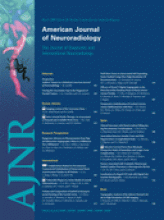Abstract
BACKGROUND AND PURPOSE: Distal embolism and acute thrombosis due to rupture of a vulnerable atherosclerotic plaque are the common mechanisms of stroke in patients with carotid disease. The purpose of this study was to develop the first animal model of vulnerable carotid atherosclerotic plaque.
MATERIALS AND METHODS: Carotid atherosclerotic models were created in 12 Yucatan minipigs by using a combination of partial ligation and high cholesterol diet. Retia mirabilia from these animals were examined histopathologically to identify distal embolism. The association of distal embolism with advanced atherosclerosis and a thin fibrous cap was analyzed by using the Fisher exact test.
RESULTS: Typical features of vulnerable plaques, including a thin fibrous cap, necrotic core, and intraplaque hemorrhage, were observed in this swine model of carotid atherosclerosis. Distal embolism was detected in retia mirabilia supplied by 7 of 10 carotid arteries with advanced atherosclerotic plaques, compared with 3 of 14 carotid arteries without advanced plaque (P < .05).
CONCLUSIONS: This swine model of carotid atherosclerosis contains the salient features of vulnerable plaques, including plaque rupture and distal embolism.
- Copyright © American Society of Neuroradiology












